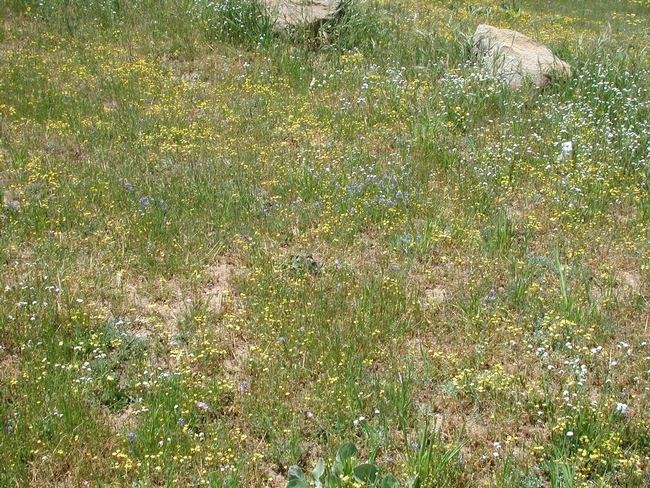From the Invasive Plants in Southern California blog :: June 11, 2014
Preemergence herbicides for wildland weed control
Kill weeds before they ever see the light of day; sounds great, doesn't it? That is what preemergence herbicides are for. They are a mainstay in commercial agriculture and ornamental landscapes, so why not in wildlands? While there are situations where they would be very helpful I have some concerns that make me reluctant to recommend them in general.
First of all, what is a preemergent herbicide? (The shorthand version is PREE, so I'll use that term for the rest of this blog.) These are herbicides that kill germinating seedlings of susceptible species. To be effective PREE herbicides have to be in the soil, so they are either applied directly to the soil or are the residual of a herbicide that is applied postemergence (POST, applied to existing foliage or aboveground parts of plants).
Most of the commonly used POST herbicides, like triclopyr, imazapyr, chlorsulfuron, fluazifop and others have PREE activity following their application to living plants; some more than others. (I'll do a follow-up blog on the PREE activity of these herbicides; it's kinda complicated and deserves more discussion.) Glyphosate is the exception; it has no activity in the soil after application. There are other herbicides that only have PREE activity and have little or no effect on plants when sprayed on foliage. These are the ones that I want to discuss further in this blog post.
So why don't I like to recommend these PREE herbicides? The reasons are several, but this is not an absolute condemnation. These are really useful herbicides, but there are some important issues with regard to wildland use.
- Labels. In order to legally and ethically use a herbicide on a particular location it has to have that site on the label. So a herbicide that says for use in alfalfa, cotton and rice, but has no mention of wildlands, forests, range, non-crop, etc. cannot be used on any of those sites. In a previous blog (A couple of herbicide legal niceties) I discussed the case of Ronstar Flo (oxadiazon), which was being considered for some wildland restoration sites in southern California. To quote myself, “Unfortunately, the title page of the label it says, "For sale to, use and storage by commercial nursery, turf and landscape personnel only. Not for use on home lawns."” I further discussed the legal and regulatory situation in that blog, but bottom line – even though you can go into a herbicide sales office and buy the herbicide, that doesn't make it OK to use that herbicide on a site that is not on the label.
- Efficacy. Efficacy is a favorite word of weed scientists; it refers to the ability of the herbicide to kill a weed or group of weeds. PREE herbicides have to move into the soil and have to be activated in order to be efficacious. Moving the herbicide into the soil in agriculture or a landscape is generally done with irrigation water, usually sprinklers; sometimes it is done mechanically with a disc or roto-tiller. Overhead water is typically far more effective than drip irrigation or surface irrigation. The water also activates (e.g. turns on) the herbicide; the herbicide only kills seed that are germinating and the herbicide has to be in the soil water solution. In a wildland situation, the water source is rainfall, which is so unreliable in southern California. So if you use a PREE herbicide you either pray for rain or you bring in supplemental irrigation; probably not something most of us want to do under drought conditions. Even under agricultural conditions, activating a PREE herbicide with irrigation correctly can be
very, very challenging. - Selectivity. This is the most troubling problem in my opinion. PREE herbicides typically control a wide range of plant species. This range can be unpredictable or unknown. Plants are killed in the soil so you never see them emerge. In agriculture the herbicide has to kill weeds but do no damage to the crop. A crop is only one species, so finding a selective PREE herbicide is doable. But what is going on when you have a multiple and variable number of native species in the soil? You won't know which native plants you killed because you never see them. The only way to gain this type of knowledge is through repeated field research studies, which will take years and will never include all of the plant species, native and weedy, that you want to study. Look at the picture; it shows multiple species of natives and non-natives. Which one of these would you predict would germinate in this site?
So, it's complicated and risky, but might still be a viable option for some situations. Maybe the site is so degraded by years of farming and ranching that you are certain that there are no natives still present in that site. Maybe a PREE herbicide program is part of a more extensive re-vegetation project, so you are not trying to rescue a native population. Maybe you are trying to rescue one species and you know that the PREE herbicide doesn't kill plants in the same family. Maybe?
